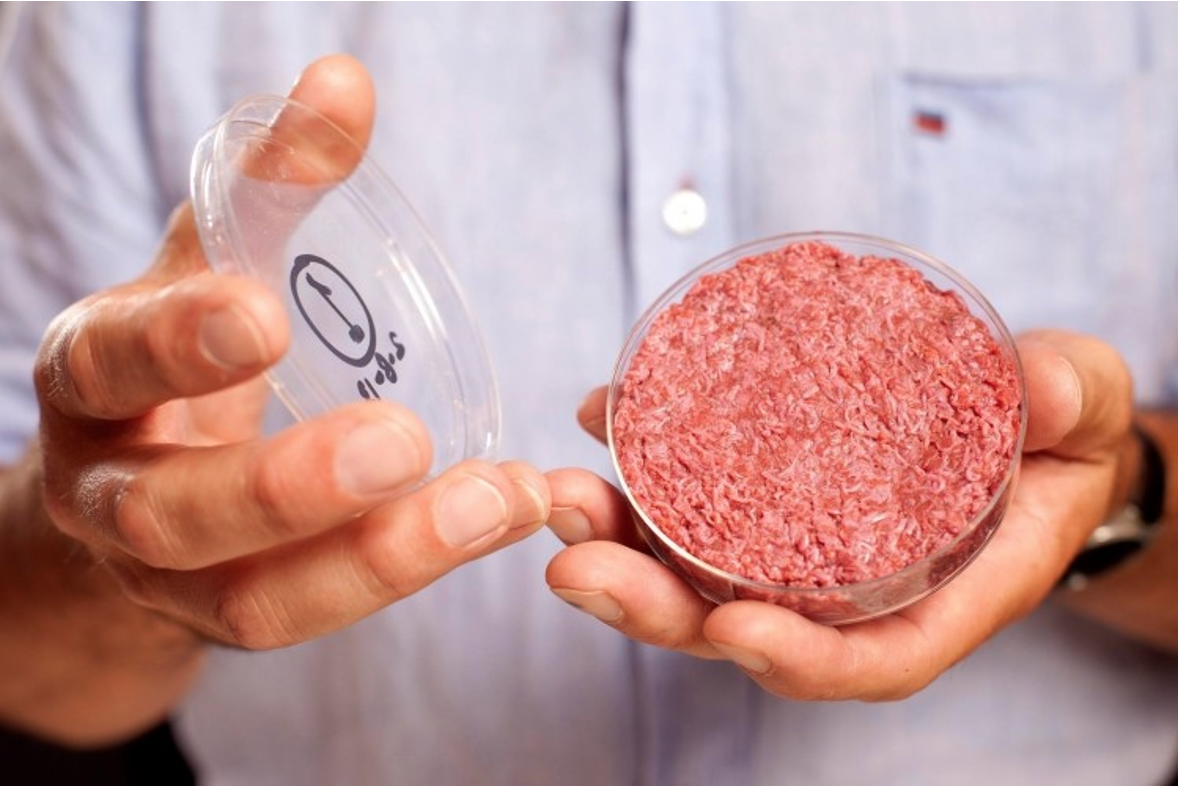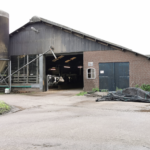Photo Credit: Mosa Meat
Conventional meat and dairy production and consumption has a large impact on the health of the planet and its inhabitants. Climate change, land system change, biodiversity loss, fresh water use, disruption of nitrogen and phosphate cycles, ocean acidification as well as a range of direct impacts on human health are all to some extent attributed to livestock keeping and meat and dairy consumption. In addition, there are serious animal welfare concerns about large scale livestock keeping for human consumption. A great food transformation, as advocated by the EAT-Lancet Commission on healthy diets from sustainable food systems,[1] as well as by the Intergovernmental Panel on Climate Change (IPCC),[2] the Intergovernmental Science-Policy Platform on Biodiversity and Ecosystem Services (IPBES)[3] and the Food and Agriculture Organization (FAO)[4] is inevitable.
A transition to plant-based diets would solve most, if not all, of the above mentioned negative impacts of livestock keeping.[5] A simple illustration of this is the fact that the 77 percent of the agricultural land that is used for livestock keeping, only gives us 18 percent of our calories. 83 percent of our calories are obtained from the remaining 23 percent of agricultural land.[6] A plant-based diet, therefore, needs much less space. The question rises, though, whether we can turn the entire world population into vegetarians and vegans.
The EU’s Farm to Fork Strategy addresses the consumer: ‘It is clear that the transition [to sustainable food systems] will not happen without a shift in people’s diets.’[7] A potentially disruptive technological change is the introduction of cultured meat and animal-free dairy which may have a far reaching impact not only on the agricultural sector but on the environment as well since replacing animal-grown meat and animal produced milk with lab-grown meat and dairy has the potential to reduce livestock emissions to zero, reduce the current nitrogen and phosphate overload, and transform landscapes through the allocation of space now used for grazing and for the production of animal feed to other uses, without a full transition to plant-based food.
The EU’s Farm to Fork Strategy does not explicitly mention cultured meat and dairy. It only, generally, advocates moving to a more plant-based diet with less red and processed meat,[8] and it advocates research on ‘increasing the availability and source of alternative proteins such as plant, microbial, marine and insect-based proteins and meat substitutes.’[9] It is unlikely, therefore, that the various regulatory proposals to implement this strategy, such as the regulation on a framework for sustainable food systems (which is currently being drafted), will focus on the actual production and marketing of cultured meat and dairy. The market, however, seems to be much faster than what the drafters of the Farm to Fork Strategy had in mind. On 1 January 2023, 31 companies producing cultured meat had been established and were operating around the world, delivering their products to supermarkets and restaurants.[10] It is therefore safe to assume that policymakers will have to catch up sooner rather than later and seize this opportunity to promote cultured meat and dairy as one of the tools in the toolbox for the agriculture and food transformation.
What would be the role of law to achieve a EU wide dietary shift in consumption from conventional meat and dairy to cultured meat and dairy? More specifically, what regulatory interventions are needed to achieve large scale production and consumption of cultured meat as one of the ways to reduce the production and consumption of conventional meat and dairy? There are five interconnected categories of regulatory interventions which are relevant: 1) laws aimed limiting the production and demand of conventional meat and dairy, 2) laws aimed at stimulating the production and demand of cultured meat and dairy, and 3) laws aimed at ensuring that cultured meat production is safe, 4) fair and 5) sustainable.
1. It is important to develop a broader regulatory approach aimed at reducing conventional meat and dairy to prevent that cultured meat and dairy will not replace conventional meat and dairy, but instead will just become new products on the food market that just create additional effects.[11] Such broader regulatory approach is now missing in the EU, although the regulatory pressure on conventional livestock farming is mounting. It can be assumed that especially European climate laws will increase the price of conventional meat and dairy considerably in the coming ten years or so, with the adoption of strict methane emission reduction targets under the LULUCF Regulation and a carbon pricing mechanism for agriculture, for example as part of the EU ETS. In regions with high livestock density environmental standards on water quality, air quality and nature conservation are already forcing member state governments to reduce livestock numbers.
2. Research indicates that non-regulatory approaches are important as well, especially the provision of information to improve willingness to accept cultured meat.[12] Although animal welfare and ecological concerns are the most influential positive drivers of consumers’ attitudes towards cultured meat, there also are emotions and perceptions on “non-natural” novel food technology (‘food neophobia’).[13] The perceived naturalness or unnaturalness of cultured meat plays a major role in consumers’ acceptance of cultured meat.[14] Governments, as well as the wider food industry will have to address these perceptions and possible concerns in information campaigns and in the public debate.
3. The EU already has comprehensive rules in place that aim to guarantee that new food products on the market are safe. Cultured meat and dairy will have to be authorized by the European Commission under the Novel Foods Regulation,[15]and, in case genetic modification is used, under the EU’s GMO legislation.[16] Novel foods authorization largely depends on the advice given to the European Commission by the European Food Safety Authority (EFSA). In its assessment, EFSA focuses on two aspects: is the novel food safe and is it not nutritionally disadvantageous?[17] By early 2023, no cultured meat and dairy products had gone through the authorization phase yet. Therefore, no cultured meat and dairy products had been placed on the EU market by early 2023.[18] The accuracy of information provided to consumers on food products has already been regulated in de detailed way as well,[19] which should prevent the risk that cultured meat will be attempted to pass as conventional meat or vice versa.
4. Legislation is also needed to make the agricultural and food transition fair, especially for farmers. The role of farmers is important as in the transition process, sufficient economically viable options need to be present, including playing a role in the production process of cultured meat and dairy. For plant-based meat and dairy products, the opportunities for farmers are quite obvious, as the growing demand for plant-based alternatives for meat and dairy leads to an increased demand for crops such as soy, lentils, peas, and other legumes. For cultured meat, however, this is more uncertain at the moment as it is unclear what feedstock will be used by the cultured meat and dairy industry. Research indicates, however, that it may be very well be possible that traditional agricultural crops will be used as input (e.g., barley, beets, corn, peas, soy, sugarcane, wheat), although also less traditional crops will play a role as well (e.g., algae, fungi, seaweed, yeast, and a range of bacteria for cultured milk fermentation processes).[20] In addition, some farmers may keep a small herd of animals to provide the cells necessary for cultured meat production.[21] It may even be possible to place the cultivators on farms in case of more localized production, aiming for consumers demanding for locally produced products.[22] Finally, producers of cultured milk may deliver their product to farmers who then produce cheese and other dairy products on their farm.[23]
All of the above is primarily ruled by the market, but regulators may choose to intervene for example by requiring cultured meat producers to involve (local) farmers. Such interventions may limit the risk that a small number of large multinational corporations monopolize the production of cultured meat and dairy. Ideally, such market intervention should happen at the EU level so as to avoid or at least reduce potential conflicts with competition law. It should be stressed here that for the current livestock farmers, their role in the production of cultured meat and dairy (and plant-based products for that matter) is only one of many ways to transition to a more sustainable farming business. In fact, these farmers will have to completely reinvent their farm. Many, if not all of them will need to be assisted in this transition towards a drastically different type of farming business. They need financial and practical support and sufficient time to make the transition. As there are many different roads to a more sustainable farming business for each individual farm, based on local environmental circumstances, individual preferences and expertise, local and regional markets, etc., an individualized approach will be necessary. The government could, for example, roll out a large program which allows farmers to hire consultants who help them with the transition. Newton and Blaustein-Rejto also mention the option for the government ‘to create and/or support wider policies and programs that support just transitions for farmers and rural communities, including debt forgiveness, compensating for losses incurred, and funding (re)training initiatives’.[24] Part of such wider policy will also be the instruments aimed at rewarding farmers for those environment, climate change and biodiversity related measures, especially in the CAP and the LIFE program. Member States can use the National Strategic Plans under the CAP to implement their policy to help livestock farmers diversify their farm. Other market opportunities for farmers are the selling of carbon credits obtained through carbon sequestration measures on their lands under private and public carbon farming schemes.[25] Increasing attention for rewilding across Europe, and especially its focus on large herbivores, also offers opportunities to livestock farmers to contribute to such plans through agricultural rewilding, such as breeding and ranching reintroduced species, possible with associated eco-tourism activities.[26]
5. Finally, the production of cultured meat and dairy has to happen sustainably. The main environmental concern is the energy use and associated carbon footprint of cultured meat and dairy. Reliance on renewable energy for the production of cultured meat and dairy is to be preferred. The other potentially unsustainable development in the wake of the transition to cultured meat and dairy is unsustainable use of the agricultural lands that become available through decreasing ranching areas and decreased animal feed production. Land use laws can be used to guide this development. Linking the agricultural and food transition to biodiversity policies and rewilding will limit the emergence of this risk.
It is clear that regulatory authorities in the EU and its Member States cannot leave the emergence of cultured meat and dairy to market forces. Early intervention and guidance of this new technology seems desirable and may help us to save our planet.
21 March 2023
This blogpost is a short summary of a research paper which will be published as a chapter in: Alexander Zahar and Leonie Reins (eds.), Climate Technology and Law in the Anthropocene (forthcoming). The chapter will be titled: ‘Cultured meat and dairy as a game-changing technology in the agricultural and food transition in the EU: what role for law?’
This research was made possible through funding from the Netherlands Research Council NWO under grant number 406.18.RB.004
[1] W Willet et al, ‘Food in the Anthropocene: the EAT–Lancet Commission on Healthy Diets from Sustainable Food Systems’ (2019) 393 The Lancet 447-492.
[2] GJ Nabuurs et al, ‘Agriculture, Forestry and Other Land Uses (AFOLU)’ in PR Shukla et al (eds), Climate Change 2022: Mitigation of Climate Change. Contribution of Working Group III to the Sixth Assessment Report of the Intergovernmental Panel on Climate Change (CUP 2022).
[3] S Diaz et al, Summary for Policymakers of the Global Assessment Report on Biodiversity and Ecosystem Services of the Intergovernmental Science-Policy Platform on Biodiversity and Ecosystem Services (IPBES 2019) 18.
[4] FAO, Transforming Food and Agriculture to Achieve the SDGs. 20 Interconnected Actions to Guide Decision-makers (FAO 2018).
[5] Nicholas Bowles, Samuel Alexander, Michalis Hadjikakou, ‘The Livestock Sector and Planetary Boundaries: A ‘Limits to Growth’ Perspective with Dietary Implications’ (2019) 160 Ecological Economics 133.
[6] Hannah Ritchie and Max Roser, Land Use, Our World in Data (2019), available online, https://ourworldindata.org/land-use.
[7] Communication from the Commission to the European Parliament, the Council, the European Economic and Social Committee and the Committee of the Regions, ‘A Farm to Fork Strategy for a fair, healthy and environmentally-friendly food system’ COM(2020) 381 final, 5.
[8] Ibid., 13.
[9] Ibid., 15.
[10] Dale Cudmore, 25+ Lab Grown Meat Companies: The Complete List (2023), available online, https://vegfaqs.com/lab-grown-meat-companies/.
[11] Stephens calls this the ‘addition effect’, Neil Stephens et al, ‘Bringing Cultured Meat to Market: Technical, Socio-Political, and Regulatory Challenges in Cellular Agriculture’ (2018) 78 Trends in Food Science & Technology 162.
[12] Ashkan Pakseresht, Sina Ahmadi Kaliji, Maurizio Canavari, ‘Review of Factors Affecting Consumer Acceptance of Cultured Meat’ (2022) 170 Appetite 105829, 4-6.
[13] Ibid., 7-9.
[14] Ibid.
[15] Regulation 2015/2283/EU of the European Parliament and of the Council of 25 November 2015 on novel foods [2015] OJ L 327/1.
[16] Including Regulation 1829/2003/EC of the European Parliament and of the Council of 22 September 2003 on genetically modified food and feed [2003] OJ L 268/1 and Directive 2009/41/EC of the European Parliament and of the Council of 6 May 2009 on the contained use of genetically modified micro-organisms [2009] OJ L 125/75.
[17] Art. 11(2).
[18] Information provided on EFSA website in funding call (23 April 2023 deadline), see https://www.efsa.europa.eu/en/funding-calls/cultured-meat-and-cultured-seafood-state-play-and-future-prospects-eu. There are concerns that the authorization process is too demanding, Anu Lähteenmäki-Uutela et al, ‘Alternative Proteins and EU Food Law’ (2021) 130 Food Control 108336, 8-9.
[19] Regulation 1169/2011/EU of the European Parliament and of the Council of 25 October 2011 on the provision of food information to consumers [2011] OJ L 304/18.
[20] Peter Newton, Daniel Blaustein-Rejto, ‘Social and Economic Opportunities and Challenges of Plant-Based and Cultured Meat for Rural Producers in the US’ (2021) 5 Frontiers in Sustainable Food Systems 624270, 4.
[21] Ibid., 4-5.
[22] Ibid., 5.
[23] Ibid.
[24] Ibid., 8.
[25] In 2023, the European Commission will publish a legislative proposal for a regulatory framework for certifying carbon removals, see https://climate.ec.europa.eu/eu-action/sustainable-carbon-cycles/carbon-farming_en.
[26] See section 4 above.



